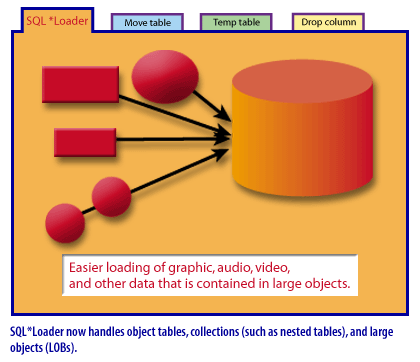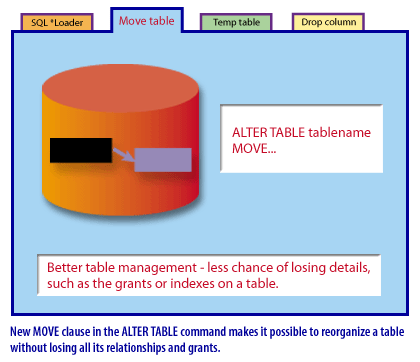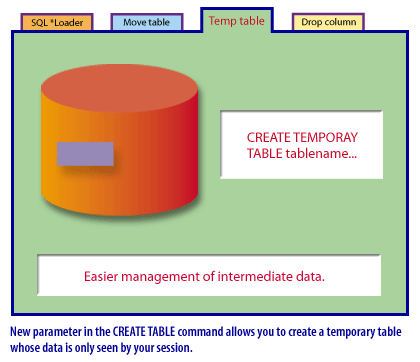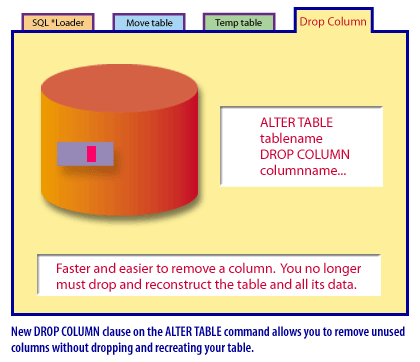| Lesson 4 | Features for large databases |
| Objective | Describe features for large databases. |
Large Databases using Oracle Administration
A variety of features and enhancements in Oracle9i improve efficiency for larger databases, for example, better handling of data loading and table storage.
The table below lists these items and their benefits. Later on in this course, you will get a chance to practice most of these new elements. Observe the slide show below to see the four major enhancements that help you work with large databases.
Key points about Oracle's large database introduction:
Key points about Oracle's large database introduction:
- Based on Codd's paper: The concept of a relational database was based on a paper by Edgar F. Codd titled "A Relational Model of Data for Large Shared Data Banks".
- Early market entry: Oracle was the first company to bring a commercial RDBMS to market.
- Significance: This allowed organizations to manage large datasets efficiently using a structured approach.




What is a Large Database?
Let us begin by describing what we mean by a large database. Large is a relative term that changes over time. What was large five or ten years ago is small by today's standards, and what is large today will be considered small a few years from now. Each release of Oracle has included new features and enhancements to address the need to store more and more data. For example, Oracle was released in 1999 and could handle databases with terabytes (1024 gigabytes) of data. In 2001, Oracle9i was released and could deal with up to 500 petabytes (1024 terabytes). Oracle Database 10g now offers support for exabyte (1024 petabytes) databases. You will not come across too many databases with exabytes of data right now, but in the future at least we know Oracle will support them. The most obvious examples of large database implementations are data warehouses and (DCS) decision support systems.
These environments usually have tables with millions or billions of rows, or wide tables with large numbers of columns and many rows. There are also many OLTP systems that are very large and can benefit from the features we are about to cover.
These environments usually have tables with millions or billions of rows, or wide tables with large numbers of columns and many rows. There are also many OLTP systems that are very large and can benefit from the features we are about to cover.
- Large Oracle Databases have performance This report cites a survey noting that the percentage of terabyte-sized Oracle databases increased 18%, with 31% of DBA's reporting terabyte Oracle databases. The most important note in this survey is that the large database are suffering from chronic performance issues related to the high data volumes. According to the study, 60 percent of the 335 members of the Chicago-based IOUG reported that a lack of available storage has affected database performance, with others saying that they have delayed application rollouts because of a lack of storage resources. Oracle has many underutilized features for very large databases, including partitioning and data caching that help resolve data-volume related performance problems, and properly implemented, Oracle database can grow into multi-terabyte size without any performance degradation.
Oracle's concept of "Large Database" from Oracle 12c to Oracle 23ai
The concept of a "large database" in Oracle has evolved significantly from Oracle 12c to Oracle 23ai, reflecting broader changes in technology, data management needs, and Oracle's strategic direction. Here’s an overview of how this evolution has unfolded:
Overall, the definition and handling of "large databases" in Oracle have transitioned from a focus on raw capacity and manual optimization to leveraging AI, machine learning, and cloud integrations to manage massive, dynamic datasets efficiently and securely.
- Size and Scale:
- Oracle 12c: Introduced around 2013, Oracle 12c (where "c" stands for "cloud") was designed with capabilities to manage databases efficiently that are large by the standards of that time. The introduction of features like the Multitenant architecture allowed for easier management of multiple databases, which could collectively represent a large dataset.
- Oracle 23ai: Advances in hardware, storage technologies, and Oracle’s software capabilities mean that what constitutes a "large database" has changed dramatically. Oracle 23ai, which integrates more deeply with cloud services and artificial intelligence, can handle petabyte-scale databases more effectively, reflecting the exponential growth in data generation and the demands for real-time, high-volume data processing.
- Data Handling and Performance:
- Oracle 12c: Featured improvements in data optimization, indexing, and partitioning to manage larger databases more effectively. Technologies such as In-Memory databases began to play a significant role.
- Oracle 23ai: Enhances these capabilities with more advanced data partitioning, automated data management using AI to optimize queries, and better in-memory computing. The integration of AI allows for more predictive and adaptive performance tuning and real-time analytics at a scale not previously feasible.
- Cloud Integration:
- Oracle 12c: Was a pioneer in Oracle's push towards the cloud, offering options for both on-premise and cloud deployment, focusing on scalability and flexibility.
- Oracle 23ai: Likely represents a much deeper integration with cloud technology, with nearly seamless movement between on-premises and multiple cloud environments. The use of Oracle Autonomous Database technology, which automatically encrypts, backs up, updates, and tunes itself, plays a crucial role.
- Features and Technologies:
- Oracle 12c: Introduced features like Advanced Compression and Hybrid Columnar Compression to manage larger data volumes more efficiently.
- Oracle 23ai: With the continuous advancement in Oracle’s software, the later versions would leverage machine learning and AI not just for database management but also to provide insights and enhanced security features tailored to the needs of huge, complex datasets.
- Database as a Service (DBaaS):
- Oracle 12c: Early stages of offering DBaaS with the flexibility to manage fluctuating workloads.
- Oracle 23ai: More robust and mature offerings in DBaaS, fully harnessing the cloud's elastic capabilities to provide a scalable and cost-effective service for managing extremely large databases.
- Security:
- Oracle 12c: Enhanced security features to protect large databases but still primarily reliant on manual configurations and monitoring.
- Oracle 23ai: Likely includes advanced, AI-driven security protocols, real-time threat detection, and automatic responses to security incidents, essential for managing large-scale databases in an era of increasing cyber threats.
Overall, the definition and handling of "large databases" in Oracle have transitioned from a focus on raw capacity and manual optimization to leveraging AI, machine learning, and cloud integrations to manage massive, dynamic datasets efficiently and securely.